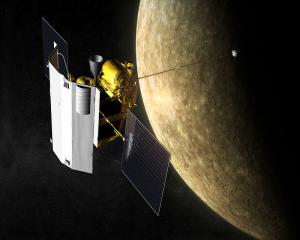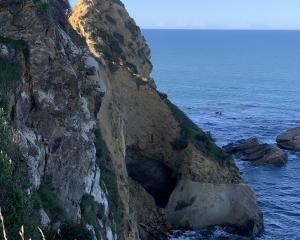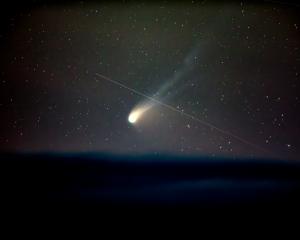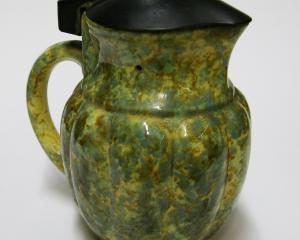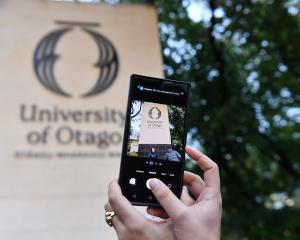The holy grail of drawing power from the waves drew an invited crowd of prominent Dunedin citizens to the beach just south of St Clair in March, 1903.
Robert Miller of Dunedin had stretched a wire cable across a cove and a floating pontoon of logs was connected to it by a wire rope at each corner. The ropes ran through pulley blocks suspended from the cable and then to the "power machine" on the beach. With a rope at each corner, every movement of the pontoon provided power because when one corner was rising, another was falling.
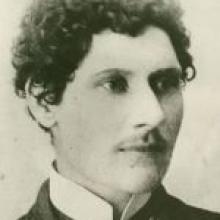
The worthies examined the workings, stroked their chins and were duly impressed. The Otago Witness surmised there could be an unlimited number of pontoons and unlimited power.
A syndicate took out a patent on Miller's invention but the project faded into oblivion and wave-power projects disappeared for a hundred years.
Today, many countries are looking to the waves for energy and some small wave-power stations are up and running. New Zealand itself has several experimental projects under way.
Inland in 1903, Otago had another man ahead of his time in producing "green" energy. Ernest Hayes harnessed not the waves but the wind. English-born, he was apprenticed as a millwright, married and emigrated to New Zealand in 1882, settling at Oturehua in Central Otago.
There he ran flour mills and developed a farm. In 1910 he built his first wind turbine to provide power to his small workshop. A complex arrangement of shafts and pulleys transferred the power from the huge, multi-bladed sails to the workshop.
In 1912 he started to produce windmills for pumping water on farms and they were so effective they were soon all over the province. His inventive genius created a host of practical inventions to help the farmer, most famously wire strainers, and they were so successful that they or derivatives are still being manufactured today.
The fickleness of the wind eventually frustrated him so much that water took over as the motive power for his workshop in 1927. People in the homestead could turn the electricity on or off by means of a system comprising a bike spoke and chain connected to wires running to the water wheel (or Pelton Wheel).
Meridian has given his name to the current, controversial project to build the biggest windfarm in the southern hemisphere on the Lammerlaw Range in inland Otago.
While Miller and Hayes were making use of raw energy in Otago, Ernest Godward was making a refined energy go further in Invercargill.
He had been sickly as a child in England and did not start school until 9 years of age. Three years later he ran away to sea. In 1886, aged 17, he arrived in Dunedin and in the early 1890s became a partner in the Southland Cycle Works. He married in 1896; he and wife Marguerita were to have 10 children.
The cycle shop was not enough for Godward's fertile brain. By 1900 his many inventions included a better eggbeater, post-hole borer, hair curler and lid for cans and a burglar-proof window. Most significantly, for his pocket, in 1901 he put a spiral in the hairpin and became wealthy, selling the US rights for 20,000.
In 1908 he started a motorcycle business in Invercargill and fitted the imported bikes with his petrol economiser. It was a precursor of the modern carburettor, converting petrol into gas before ignition. It was reputed to increase horsepower by 15%.
Encouraged by the success of his inventions in America, he moved to New York in 1916 and based himself there the rest of his life. His petrol economiser, or Vaporizer, was commercially successfully and in 1929 there was special satisfaction when the city of Philadelphia had it fitted in some 580 buses and 3000 taxis.
In 1936 he was returning to Invercargill when he died at sea. He had over-achieved to the last - he collapsed after winning a skipping competition.
Another brilliant inventor in the South Island, a recluse at Waitohi, inland from Timaru, turned out to be the most famous of them all. Richard Pearse took out his first patented invention for a new sort of bicycle in 1902.
In an age when most people walked or used the horse, the bicycle was advanced technology. Pearse put his stamp of genius on it. The frame was light - bamboo - the pedal action was not round but up and down, the gearing system was unique and the tyres could be pumped up while riding.
That year or the next, he became indisputably one of the first people in the world to have a powered takeoff into the air.
His flight was not long enough or controlled enough for him to claim the first powered flight (he agreed), but his aircraft had features far ahead of its time - it was a monoplane with wing flaps and a rear elevator, tricycle undercarriage, steerable nosewheel, propeller with variable-pitch blades made of metal and a petrol engine designed for use in flight. He patented it in 1906.
Where Godward was gregarious and an astute businessman, the solitary Pearse was more concerned with inventing than selling. He did turn his constructing ability to some advantage - he later built three houses in Christchurch and lived off the rental income.
For thinking "outside the square" in using nature for technological purpose, Robert Ellis of Brightwater must be celebrated. He had bought a flour mill there in 1910 and installed a turbine in place of the water wheel.
From 1914 he made flour by day and power by night, lighting the lamps of Brightwater and Richmond. But he had a dilemma - how to automatically turn the lights on and off at dusk and dawn?
Then inspiration struck - he devised a switch that was operated by the weight of the chickens on their perch. When they left in the morning, the power went off and when they returned at dusk, the power went on.
• Denis Dwyer is a Palmerston North writer with Otago family connections.


